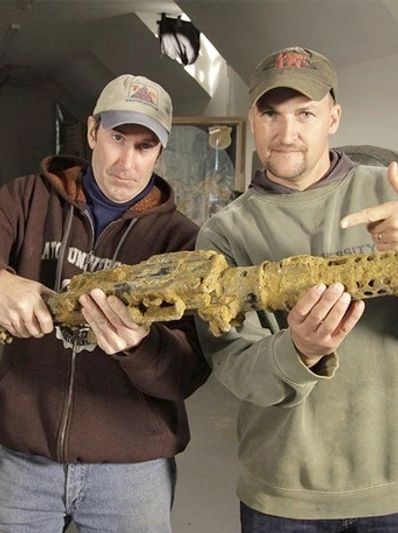The Dig Story
Buried Airplanes at Freeman Field ???
After WW-II was over (1945) the multi-engine pilot training facility at Seymour, Freeman Army Airfield, was not immediately closed. Instead, for about a year, it was repurposed into the Foreign Aircraft Evaluation Center. Approximately 160 enemy aircraft, primarily German but some Japanese and Italian, were brought here for study and testing. Most of the aircraft came by ship and then rail, partially disassembled. Larger bombers were flown here from Europe.
Some of the planes were put back together and flight tested. Others were further disassembled for engineering analysis. This evaluation went on for about a year. After the program was completed at the end of 1946 the base was sold to the city of Seymour for $1, with the caveat that the military could take back if war broke out again. The airplanes that were flyable or nearly intact were dispersed to museums across the country. Many were scrapped. What remained was a whole lot of airplane parts scattered around in several large hangars. Those parts were considered to be junk. They were loaded into trucks, taken to various places on the airfield, and buried. That was about 65 years ago.
In the 1990’s there was a lot of interest from outside groups about the items buried at Freeman Field. That’s because it was originally thought that there were perhaps 14 whole airplanes buried here. There are accurate records of what aircraft were brought to Freeman Field, and where they went after the evaluation period was over. 14 of the planes were unaccounted for at the end.
The first group to obtain permission to search for planes was Blue Sky, headed by WW-II aviation buff Charlie Osborn. They did some digging in the early 90’s but didn’t find anything. The next was Salvage One, led by Lex Cralley and later joined by Dallas Tohill and others from Tidewater Tech. They dug in various places for several years, and in 1997, quite by accident, began finding things. It was very hot one day and they decided to dig in a shady area. Most of the items in this room came from the 1997 dig. Not finding any whole airplanes or major structures, Salvage One abandoned operations after 1997.
In 2009 Seymour native, WW-II historian and artist, and career pilot David Gray put together a group known as the Freeman Field Recovery Team (FFRT) and obtained permission to dig for old parts and planes. While not an official sponsor, the Freeman Army Airfield Museum has played a major
supporting role throughout the FFRT efforts. The motto of the FFRT is “research more, dig less”.
Digging is expensive. They uncovered heretofore unknown aerial photographs from before, during and after WW-II. FFRT members have traveled extensively to interview persons still living who remember the era, and been to the National Archives to ferret out additional information. Along the way they found out where 11 of the 14 missing airplanes went. About a dozen sites on the field were
identified as potentially containing artifacts. Additional small items have been found, but no whole planes or engines. In 2013 FFRT presence on social media caught the attention of the producers of the National Geographic TV series, Diggers. A film crew was dispatched to Freeman Field in November, and the show aired in March of 2014.
Conclusion: While there are still items to be found by future excavation, the rumors of many whole airplanes buried here at Freeman Field are simply not true.
Larry Bothe, Curator, September 11, 2014

Freeman Army Airfield Museum
1035 A Ave., Seymour, IN 47274
Phone: 812-271-1821 Email: faafmuseum@gmail.com
Copyright © Freeman Army Airfield Museum. All rights reserved.
Federally-recognized 501.c.3 Educational Charity